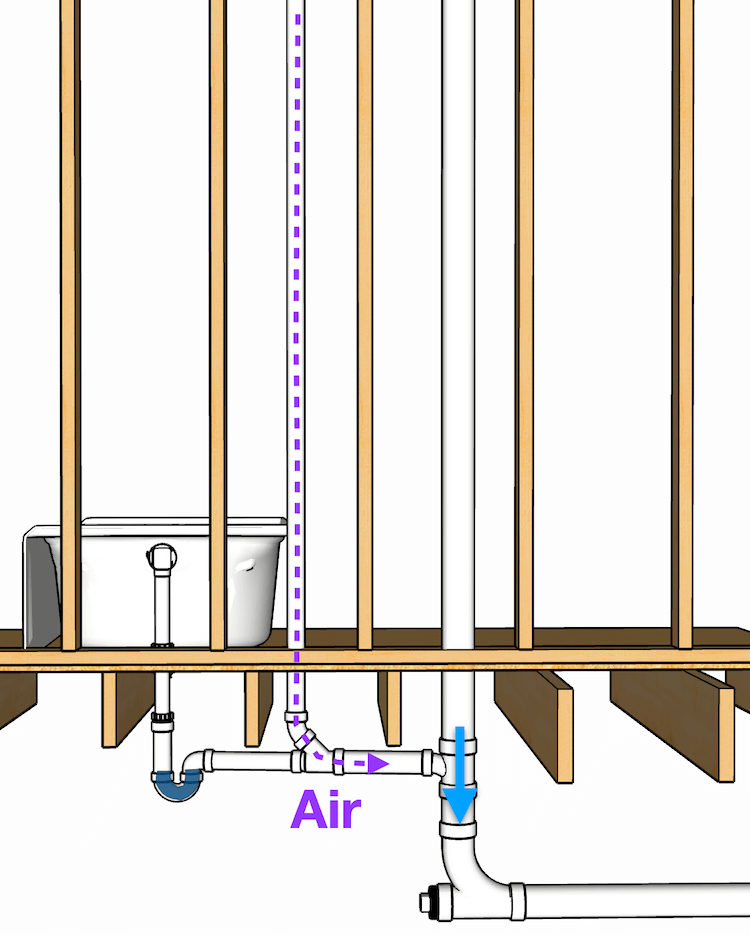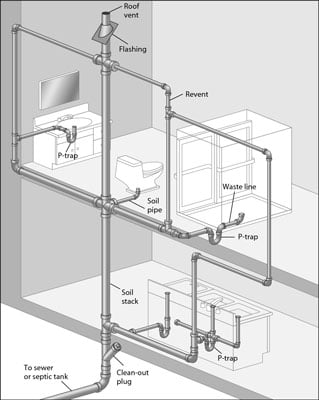Ensuring Adequate Ventilation in Your Plumbing System: Why
Ensuring Adequate Ventilation in Your Plumbing System: Why
Blog Article
This great article which follows pertaining to Why Plumbing Air Vents Are Important is unquestionably remarkable. You should read it.

Appropriate ventilation in plumbing systems is typically forgotten, yet it is crucial for keeping the capability and safety and security of your home's pipes. Ventilation aids manage air pressure, avoid the buildup of damaging gases, and ensure the effective elimination of waste. In this guide, we will certainly explore the relevance of proper pipes ventilation, just how it functions, and the advantages it brings to your pipes system.
Just How Ventilation Functions in Plumbing Equipments
Atmospheric Pressure Policy
Correct air flow maintains well balanced air pressure within the pipes system. When water streams via pipelines, it displaces air. Without adequate ventilation, this variation can produce adverse pressure, resulting in reduce drains or siphoning of water from catches, which can create unpleasant odors to permeate into the home.
Stopping Drain Gas Accumulation
Among one of the most important functions of plumbing vents is to stop sewage system gases, such as methane and hydrogen sulfide, from accumulating within the home. These gases can present severe health and wellness threats and are very combustible. Vent pipelines enable these gases to leave safely outdoors.
Helping in Waste Removal
Ventilation assists in the efficient removal of wastewater by protecting against airlocks in the water drainage system. When air can move openly with the vents, it allows water and waste to move efficiently with the pipes, lowering the threat of clogs and backups.
Advantages of Appropriate Air Flow
Boosted System Efficiency
Appropriately ventilated plumbing systems run more effectively, with less clogs, faster draining, and much less strain on the pipelines. This performance expands the lifespan of the pipes system.
Improved Air High Quality
By stopping sewage system gases from entering your home, proper ventilation adds to better interior air top quality, making your living setting healthier and more comfortable.
Avoiding Water Damage
Sufficient ventilation assists stop water from being siphoned out of catches, which can cause drain gases going into the home and triggering water damage gradually.
Steps to Guarantee Proper Air Flow
Consulting Plumbing Codes
Constantly consult regional pipes codes when developing or customizing your plumbing system. These codes give the required standards for correct venting and ensure your system meets security requirements.
Regular Evaluation and Maintenance
Routine assessments can assist identify possible air flow issues prior to they become significant issues. Maintenance jobs, such as cleaning vent pipelines and checking for clogs, are necessary for keeping the system in good working order.
Specialist Installation
For new installments or significant adjustments, it's important to hire a specialist plumbing. They have the knowledge to make sure the ventilation system is appropriately made and installed according to code.
Understanding Ventilation in Pipes
Air flow in pipes describes the network of pipes that allow air to move via the drainage system. These vents serve multiple objectives, consisting of regulating atmospheric pressure within the pipes, stopping sewage system gases from entering the home, and helping in the smooth circulation of wastewater.
Sorts Of Pipes Vents
Main Stack Vent
The primary pile air vent, likewise called the air vent pile, is the key vent in a pipes system. It extends from the main drain line up through the roofing, enabling gases to escape and fresh air to get in the system.
Branch Vent
Branch vents connect to the primary pile vent and serve specific fixtures, such as sinks, commodes, and showers. These vents ensure that each fixture has adequate ventilation to operate properly.
Air Admission Valve (AAV).
An Air Admission Shutoff (AAV) is a one-way valve that permits air to get in the plumbing system without the requirement for a traditional air vent pipeline extending with the roof. AAVs are frequently utilized in restorations or areas where setting up a typical air vent is impractical.
Indicators of Poor Ventilation in Pipes.
Slow Draining Fixtures.
If your sinks, tubs, or commodes are draining pipes gradually, maybe a sign of poor air flow. Insufficient air circulation can develop a vacuum cleaner effect, making it challenging for water to drain pipes correctly.
Gurgling Sounds.
Gurgling audios coming from drains pipes are often an outcome of air being drawn through water traps as a result of adverse stress in the pipes. This is a clear indicator of inadequate air flow.
Unpleasant Smells.
Sewer smells inside your home are a red flag that your pipes system is not correctly aerated. This could indicate that sewage system gases are not being properly vented outside, bring about potentially hazardous conditions.
Common Ventilation Blunders.
Poor Vent Sizing.
Making use of small air vent pipelines can lead to inadequate air circulation and stress discrepancies in the system. It's necessary to use vents that satisfy the particular needs of your plumbing system.
Improper Vent Positioning.
Placing vents too far from the components they offer can lower their effectiveness. Correct placement ensures that air can move freely and effectively via the system.
Disregarding Code Demands.
Building codes supply specific guidelines for plumbing air flow. Ignoring these codes can result in a system that stops working to operate correctly and might lead to expensive fixings or health hazards.
Final thought.
Appropriate ventilation is a crucial element of any type of pipes system, making certain that it works effectively and securely. By understanding the significance of air flow, recognizing the signs of bad air flow, and taking steps to keep your system, you can prevent expensive issues and protect your home's air quality.
4 Things You Should Know About Your Plumbing Vents
What Plumbing Vents Are
Also called a vent stack, a plumbing vent is a vertical pipe attached to your drain line that runs through your roof. The plumbing vent pipe, or plumbing air vent, removes gas and odors from your plumbing system and allows fresh air to enter the pipes, helping the water to flow out of the drain pipes.
What Plumbing Vents Do
Plumbing vents have two basic functions. One of which is to allow unpleasant smelling wastewater and sewer gasses to escape your plumbing system instead of entering your home. Plumbing vent pipes are typically located on roofs, away from windows, to ensure the fumes exit the home completely.
The other function of the plumbing vent is to move fresh air into your plumbing system. This helps move water through every plumbing fixture in your house, like toilets and sink drains. Think of the way in which you need to let a little air into the bottle as you pour soda in order to make the drink flow smoothly.
Different Types of Plumbing Vents
True vent: This is the most common vent option. In simplest terms, a true vent is a vertical pipe attached to your drain line that exits through the roof. They often function as the main vent that other fixtures can connect to. Re-vent pipe or auxiliary vent: Attached to the drain line near specific plumbing fixtures, re-vent pipes run up and over to connect to the main vent. Common vent: Two plumbing fixtures installed on opposite sides of a wall are typically tied into the vent stack using something known as a sanitary cross. Wet vent: This venting option operates as a drain pipe and a vent at the same time. Wet vent drainage systems drain water from one fixture while venting the air from another. Although they’ve been used for over 100 years, wet vent systems have only recently been added to the plumbing code in many areas. If you’re planning on installing one in a bathroom remodel, make sure you check your local code prior to construction. Loop vent: For free-standing fixtures like kitchen island sinks, loop vents are ideal. These vent pipes run under the floor, rise from the P-trap, and create a loop inside the cabinet sink. Air admittance valve: An AAV is a one-way mechanical valve typically installed at the site of the plumbing fixture. AAVs allow venting to occur without having to tie into a larger venting system. They’re ideal for venting fixtures where you aren’t able to easily connect to an existing vent system. Common Plumbing Vent Issues
Although vent pipes typically don’t have water flowing through them, they’re still subject to many typical plumbing issues. For example, clogs are one of the most common problems associated with sewer vent pipes. If your vent pipe gets clogged, all of your plumbing fixtures tied into the vent stack will be affected.
A sink with a slow drain that bubbles and gurgles or a strong sewage smell around your toilet are both indicators that your toilet vent pipe is clogged. Because most vent pipes exit through the roof, old leaves, twigs or even a bird’s nest could be clogging the pipe.
Clogs in your vent pipe system cause a buildup of negative pressure, meaning that water won’t be able to flow out of your home very well. It’s similar to putting your finger over the opening of a straw to trap water inside. When you remove your finger, the water is able to flow out of the straw.
If you suspect you have any blockage in your vent, make sure you have a professional come examine the situation. Left unchecked, a blocked air vent can lead to other costly repairs, like leaks and sediment buildup.
Under Pressure
Pipe vents are essential aspects of a home’s plumbing system. Owning a home means learning about all sorts of things you never put much thought into before. But by understanding as much as you can about the important systems of your home, you can keep those budgets intact and those anxiety levels low.
https://www.homeserve.com/en-us/blog/home-improvement/plumbing-vents/

I found that blog posting about Essential Plumbing Vent Pipes: Understanding Their Role while doing a search on the search engines. Loved our write-up? Please quickly share it. Let other people discover it. I take joy in reading our article about Essential Plumbing Vent Pipes: Understanding Their Role.
Request Service Report this page